★★★½
“Germany calling…”
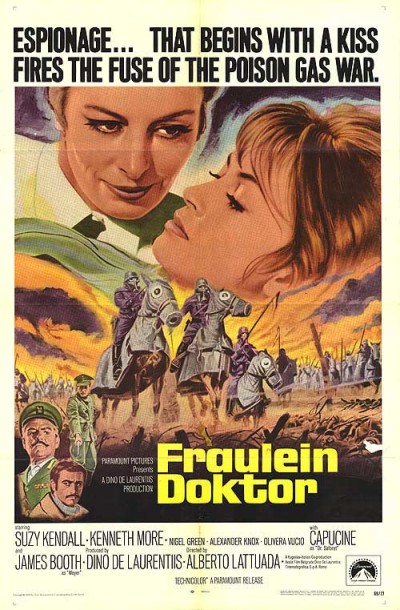 There’s a lot going on in this World War I spy thriller: probably a little too much, though it’s still generally interesting. The titular character – I wouldn’t go so far as to call her a heroine, for reasons that will become obvious – is a nameless German spy, whom we first see coming ashore at the British naval base of Scapa Flow. Her two male associates are captured, with Meyer (Booth) being “turned” by British intelligence officer, Colonel Foreman (More). Meyer reveals the fraulein’s mission is to find out on what boat Lord Kitchener will be leaving the base, so it can be attacked. Despite More’s desperate efforts, the plan succeeds and Kitchener is killed. That’s not the first time she has caused problems: in a flashback, we see her seducing French scientist Dr. Saforet (Capucine), in order to steal the secret of a dreadful new chemical weapon. Meyer, now a double-agent, is sent back into Germany with the aim of killing her, and appears to succeed. However, that’s just a ruse, so the not-so-good doctor can complete her biggest mission: organizing a raid on Allied headquarters to steal their defense plans, in advance of a massive German push.
There’s a lot going on in this World War I spy thriller: probably a little too much, though it’s still generally interesting. The titular character – I wouldn’t go so far as to call her a heroine, for reasons that will become obvious – is a nameless German spy, whom we first see coming ashore at the British naval base of Scapa Flow. Her two male associates are captured, with Meyer (Booth) being “turned” by British intelligence officer, Colonel Foreman (More). Meyer reveals the fraulein’s mission is to find out on what boat Lord Kitchener will be leaving the base, so it can be attacked. Despite More’s desperate efforts, the plan succeeds and Kitchener is killed. That’s not the first time she has caused problems: in a flashback, we see her seducing French scientist Dr. Saforet (Capucine), in order to steal the secret of a dreadful new chemical weapon. Meyer, now a double-agent, is sent back into Germany with the aim of killing her, and appears to succeed. However, that’s just a ruse, so the not-so-good doctor can complete her biggest mission: organizing a raid on Allied headquarters to steal their defense plans, in advance of a massive German push.
It’s refreshingly grey in terms of morality. Neither side comes off as occupying the high ground, and there’s very much a sense of grubby necessity. For instance, when the agent is being presented with a medal for her role in killing Kitchener, the presenting German officer refuses to shake her hand, because he considered Kitchener a fellow officer as well as a friend, and his death was “cheating”. But they are perfectly happy to use her talents: when the idea of sending a woman in is questioned, her commander replies, “Why not a woman? She has imagination, precision, courage beyond any man on any battlefield. She has only two weaknesses: traces of pity and grains of morphine.” The latter adds an extra wrinkle in her final undercover role, as a nurse on a Red Cross train, heading to the front, and she has no reluctance in using her body to achieve her goals – whether with men or women. Kendall gives a solid performance, and I was surprised to discover this was inspired by a real person, Elsbeth Schragmüller, whose identity as “Fraulein Doktor” was not revealed until almost 30 years after the end of WW1. Details of her actions are still sketchy, offering the makers a blank canvas on which to paint: no evidence she was a bi-sexual drug-addict, for instance!
As noted, there’s too much going on here. The mission to kill Kitchener could have been an entire movie in itself, as could the theft of the chemical weapon, but instead, these are galloped through at an over-anxious pace. The finale then seems to forget about its leading lady entirely, heading off in an completely different direction, depicting the German attack, both with conventional weapons and poison gas, and the effects on the Allied troops. Shown below, it is truly a nightmarish sequence of epic proportions, enhanced by Ennio Morricone’s discordant score: I believe the Yugoslav army supplied military extras, and that ups the ante considerably. It makes for a grim, rather than rousing finale, bringing home to the fraulein, the responsibility of what she has done. I can see why it was a commercial flop and has largely been forgotten, yet despite its flaws, it deserves a better fate than obscurity.
Dir: Alberto Lattuada
Star: Suzy Kendall, Kenneth More, James Booth, Capucine





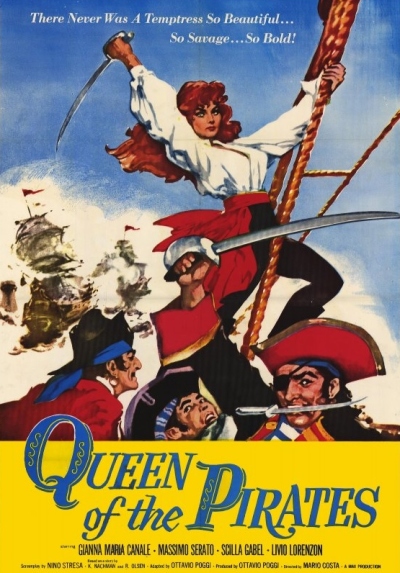 Sandra (Canale) and her father fall foul of the local tyrannical Duke (Muller) after they refuse to pay his excise duty. Arrested, the arrival of the poor but noble Count of Santa Croce, Cesare (Serato), saves them from death – or a fate worse than in Sandra’s case, as the Duke has a profitable sideline, shipping local girls off to the Middle East. After escaping, they join up with a local pirate band, who agree to help target the Duke after Sandra bests their leader in sword-play. To gain the hand of the duke’s daughter, Isabella (Gabel), Cesare agrees to hunt down the “Queen of the Pirates” who has brought trade to a standstill, not knowing that his target is the same woman he helped save, and since then has had a secret longing.
Sandra (Canale) and her father fall foul of the local tyrannical Duke (Muller) after they refuse to pay his excise duty. Arrested, the arrival of the poor but noble Count of Santa Croce, Cesare (Serato), saves them from death – or a fate worse than in Sandra’s case, as the Duke has a profitable sideline, shipping local girls off to the Middle East. After escaping, they join up with a local pirate band, who agree to help target the Duke after Sandra bests their leader in sword-play. To gain the hand of the duke’s daughter, Isabella (Gabel), Cesare agrees to hunt down the “Queen of the Pirates” who has brought trade to a standstill, not knowing that his target is the same woman he helped save, and since then has had a secret longing.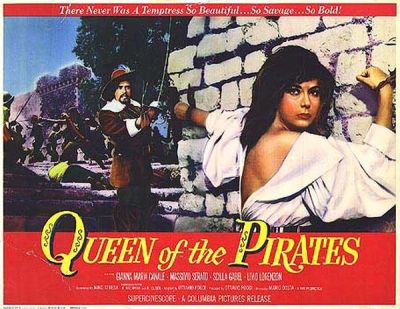

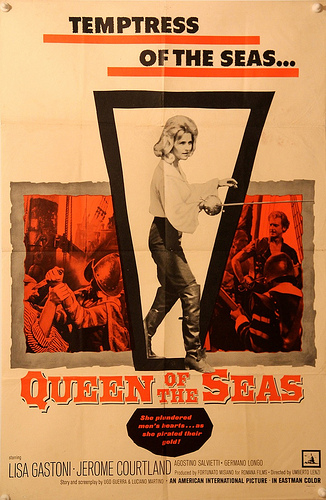 Despite its age – this was made in 1961 – it has stood the test of time fairly well, except for a romantic ending which is both predictable and unfortunate. This turns the heroine into exactly the subservient woman she spent the first 80 minutes
Despite its age – this was made in 1961 – it has stood the test of time fairly well, except for a romantic ending which is both predictable and unfortunate. This turns the heroine into exactly the subservient woman she spent the first 80 minutes 
 The tenth wedding anniversary of Donna Costanza (Alfonsi) in New Jersey is rudely interrupted when her husband is gunned down during the party. For he was a Mafia boss who, it appears, had crossed the wrong person. Before dying, he whispers to his wife, “Giarratana from Palermo,” apparently fingering the man behind the hit. Seeking revenge, Madam Costanza flies to Sicily, and meets up with a loyal family employee, soliciting his help to plan the death of the local boss fingered by her husband’s last words. But things are considerably more murky than they seem, as Costanza has wandered into the middle of some shenanigans involving a corrupt local official, a police investigation and an arms deal, which are all leaving a trail of corpses in their wake. And someone wants Donna to join the dead bodies, first trying to blow up her plane, then sabotaging the brakes on her car. When a supposedly blind man guns down her contact in the street, it’s getting too warm for comfort.
The tenth wedding anniversary of Donna Costanza (Alfonsi) in New Jersey is rudely interrupted when her husband is gunned down during the party. For he was a Mafia boss who, it appears, had crossed the wrong person. Before dying, he whispers to his wife, “Giarratana from Palermo,” apparently fingering the man behind the hit. Seeking revenge, Madam Costanza flies to Sicily, and meets up with a loyal family employee, soliciting his help to plan the death of the local boss fingered by her husband’s last words. But things are considerably more murky than they seem, as Costanza has wandered into the middle of some shenanigans involving a corrupt local official, a police investigation and an arms deal, which are all leaving a trail of corpses in their wake. And someone wants Donna to join the dead bodies, first trying to blow up her plane, then sabotaging the brakes on her car. When a supposedly blind man guns down her contact in the street, it’s getting too warm for comfort.
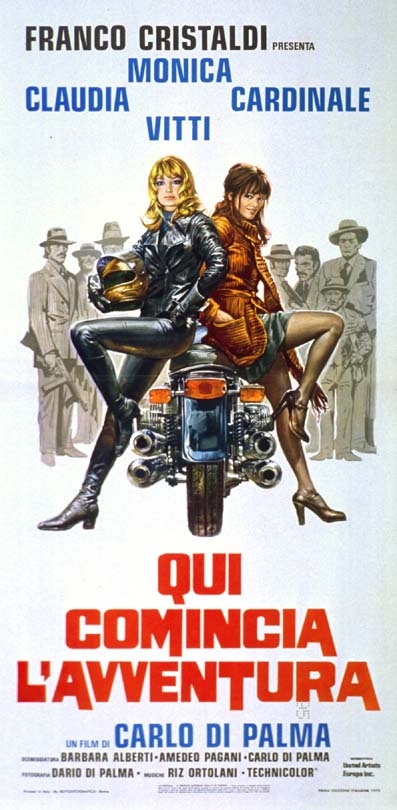 Claudia (Cardinale) has a humdrum life working in a laundrette, with a sleazy husband and no hope of anything more exciting in her future. Into the laundrette storms the titular woman, Miele (Vitti), whose devil-may-care attitude enthralls Claudia, and gives her the courage to throw away her staid existence and follow the blonde on the road. Miele is initially resistant to the idea of a travelling companion, but rides to the rescue, driving her bike through the railway station where Claudia is being harassed. Miele must make a mysterious appointment in Northern Italy with her lover, but that’s okay, as Claudia has a cousin, on the way, in Naples. However, as the two make their way, it gradually becomes clear that Miele could give Baron Munchausen a run for his money, when it comes to spinning tall tales, and both her mouth and impetuous actions, are as likely to get the pair into trouble as out if it.
Claudia (Cardinale) has a humdrum life working in a laundrette, with a sleazy husband and no hope of anything more exciting in her future. Into the laundrette storms the titular woman, Miele (Vitti), whose devil-may-care attitude enthralls Claudia, and gives her the courage to throw away her staid existence and follow the blonde on the road. Miele is initially resistant to the idea of a travelling companion, but rides to the rescue, driving her bike through the railway station where Claudia is being harassed. Miele must make a mysterious appointment in Northern Italy with her lover, but that’s okay, as Claudia has a cousin, on the way, in Naples. However, as the two make their way, it gradually becomes clear that Miele could give Baron Munchausen a run for his money, when it comes to spinning tall tales, and both her mouth and impetuous actions, are as likely to get the pair into trouble as out if it.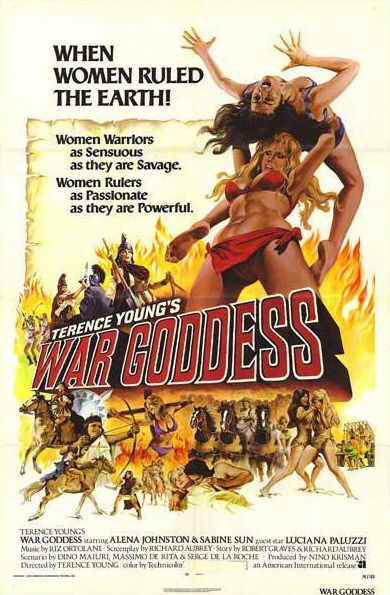
 I came into this almost entirely blind, watching it based on the title and the first three minutes off YouTube. You can understand my surprise, after Rita (Pavone) and her German sidekick (Dalla) take out a gang of stagecoach robbers, finishing off by gunning one down in the back, as he lies dazed on the ground, when they… burst into song? Yep, what I didn’t know was, this is actually a musical, designed around the talents of Ms. Pavone, who was apparently a huge pop-star in Italy in the sixties. Hence the songs. Okay, that makes a bit more sense. But it’s still an extremely odd beast, swinging from obvious spoof to apparent seriousness at the drop of a catchy tune.
I came into this almost entirely blind, watching it based on the title and the first three minutes off YouTube. You can understand my surprise, after Rita (Pavone) and her German sidekick (Dalla) take out a gang of stagecoach robbers, finishing off by gunning one down in the back, as he lies dazed on the ground, when they… burst into song? Yep, what I didn’t know was, this is actually a musical, designed around the talents of Ms. Pavone, who was apparently a huge pop-star in Italy in the sixties. Hence the songs. Okay, that makes a bit more sense. But it’s still an extremely odd beast, swinging from obvious spoof to apparent seriousness at the drop of a catchy tune. Originally, Satanik was the villain in a series of Italian photonovels/comics. But in 1964, writer Max Bunker changed the sex and this 1968 movie – set in Spain, made by Italians – followed, though Satanik isn’t mentioned by name (I guess, a little like Heavy Metal). The central character here is a disfigured scientist, temporarily turned beautiful by a potion which also removes all her morals and inhibitions. The body count mounts, and to escape the cops, she takes another woman’s identity; unfortunately, her victim was a police stoolpigeon, and those she grassed up are also very keen to find her. Plus, her medication is wearing off…
Originally, Satanik was the villain in a series of Italian photonovels/comics. But in 1964, writer Max Bunker changed the sex and this 1968 movie – set in Spain, made by Italians – followed, though Satanik isn’t mentioned by name (I guess, a little like Heavy Metal). The central character here is a disfigured scientist, temporarily turned beautiful by a potion which also removes all her morals and inhibitions. The body count mounts, and to escape the cops, she takes another woman’s identity; unfortunately, her victim was a police stoolpigeon, and those she grassed up are also very keen to find her. Plus, her medication is wearing off…